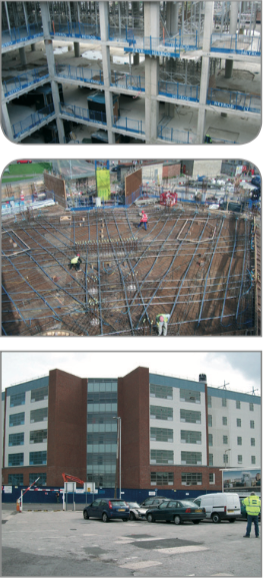 Post-tensioned slabs
Post-tensioned slabs
Client
St Helens & Knowsley Hospitals NHS Trust
Principal Contractor
Taylor Woodrow Construction
Frame Contractor
Heyrod Construction
Specialist PT Contractor
Freyssinet Ltd
Contract Value
£1.5 Million
Works Completed
December 2007
The new Whiston Hospital building is six storeys high, with ground floor access at accident and emergency and main entrance levels, utilising the slope of the existing hospital site. The new facilities occupied a total floor area of around 77,000 square metres, with a footprint equivalent to 15 football pitches.
The building was originally a RC flat plate structure, but the massive floor area would have challenged the suppliers of concrete and rebar to keep the project adequately serviced with deliveries. Post-tensioning was proposed as a means of reducing the slab thickness and material quantities as well as construction time. However, due to concerns over vibration interference at the hospital, Freyssinet commissioned a vibration study. The positive feedback from this exercise gave post-tensioning the green light and enabled the design of the structure to commence.
Due to the complexity of the building, in both its shape and construction requirements, pre-design team meetings identified the necessity for no-go zones with regard to the interface of PT and builders work holes, thus a system called the ‘golden rule’ was developed. Zones were identified that would be filled with PT elements and also punching shear zones that could not be entered by the M&E designers, therefore negating clash problems at the design stage. This added speed during construction, which resulted in the structural frame of the building being completed and handed over four weeks earlier than was originally scheduled, clawing back a 12 week delay in the original start date, relating to a 16 week saving on the overall programme.
In all, the project involved 127 pours of concrete, a conventional 3, 4 and 5S13 bonded tendon system, a general slab thickness of typically 300/325mm, a total weight of 12.9 strand of 352t, 1690 anchors, 118,400m of duct and total slab rebar of 990t. More significantly, the environmental credentials of post-tensioned construction was one of the major selling points, when the client’s team were trying to determine the construction material early on and the decision to use PT saved an estimated 4,800m3 of concrete, 2100 tonnes of steel and 775 return lorry journeys.
